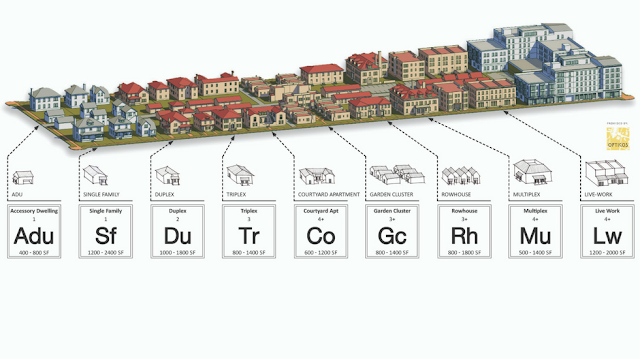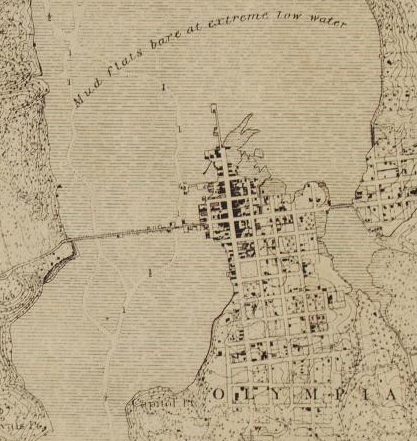Walking through downtown Olympia during Arts Walk this spring, I was struck by a realization:
Arts Walk has become what Lakefair was originally intended to be: a human-centered festival that brings people downtown and supports local businesses. What began in 1957 as a strategic effort by downtown retailers to draw shoppers back from the emerging suburban fringe has evolved, ironically, into something that now seems to conflict with its original purpose. Meanwhile, Arts Walk (especially the spring edition) has stepped into that role and done it better.
The first Lakefair took place just seven years after the Deschutes River was dammed to create Capitol Lake. Back then, Tumwater as a town stopped short of the Trosper and I-5 cloverleaf, Lacey barely extended beyond a few blocks around the St. Martin’s College campus, and Olympia’s downtown was the regional commercial hub. An aerial photo from 1957 shows a very different city. There’s no westside sprawl, no South Sound Center, no Capital Mall. Interstate 5 is only beginning to cut its path through the city. The southeast side is still a patchwork of empty fields. Downtown was everything.
Lakefair was born into that moment. The lake was new, a kind of novelty. We hadn’t built any parks around it, and people could still remember the squalor of the Depression era shanty town, Little Hollywood, the lake was meant to replace. Downtown retailers felt threatened by the spread of car-centric shopping centers to the south and west, and Lakefair was their answer: a family-friendly summer celebration rooted in Olympia’s historic center.
But the tide couldn’t be held back. By the 1980s, the construction of Capital Mall and South Sound Center pulled national retailers out of downtown. As rents dropped, local and niche businesses moved in. Downtown shrank in economic dominance, but it found something more interesting: being an actual human-scaled neighborhood. By going down, downtown Olympia grew up.
Lakefair, however, didn’t adapt. It stayed focused on big crowds and spectacle. It became a regional summer draw, people come in from Tumwater, Lacey, and the westside not to experience downtown but to experience the event. Today, the foot traffic is enormous, but not helpful. If you talk to people who live and work near downtown, many will say they avoid Lakefair. Ironically, the further someone lives from downtown, the more likely they are to enjoy it, because for some, it’s the only time they come. For those who frequent downtown, Lakefair is an interruption.
Compare that to Arts Walk. It’s right-sized. Embedded in the streets. Both the Friday night Luminary Procession and the Saturday Procession of the Species invite people not just to gather, but to stroll, to explore, and to be downtown. These events don’t shut down the regular rhythm of the neighborhood; they highlight it. Arts Walk brings people face-to-face with small businesses, galleries, performers, and each other. It’s not a performance to be watched from the sidelines; it’s an experience shared from within.
The seasonal timing is meaningful. Lakefair is scheduled for the height of Cascadian summer, long days, hot sun, and school-free weeks. But Arts Walk arrives at the beginning and end of the softer season. Spring Arts Walk, in particular, feels like a true civic ritual: the reawakening of our community after a long winter and a downtown that’s still very much alive.
Lakefair has also changed in ways that move it further from its roots. Food booths once reserved for nonprofits are now open to commercial vendors. Local nonprofits increasingly struggle to justify the effort and expense of participating. And though the Twilight Parade still winds its way through the city, it mirrors the spirit of Arts Walk’s two processions, just with a different energy: one is lighthearted and grassroots; the other, more grand and nostalgic.
There’s a larger parallel here, too. Just as Lakefair took its name and identity from the artificial lake at the city’s core, it may now face a similar fate. Capitol Lake, long celebrated as a civic centerpiece, has been revealed as ecologically harmful—shallow, warm, and lifeless. The planned restoration of the Deschutes Estuary will undo that mid-century engineering mistake, trading a static reservoir for a living tidal system. Something more natural. More fitting.
In the same way, Arts Walk fits Olympia. It flows through the streets, not around them. It thrives not in designated festival zones but in the storefronts, sidewalks, and alleys that make downtown what it is. If Lakefair is to survive in a post-lake Olympia, it can return to its roots. Maybe even borrow a few pages from Arts Walk. Move into the streets. Shrink the footprint. Reconnect with the businesses and people downtown.
I’m not a Lakefair hater. I have fond memories, and I go down there for at least two nights a year for rides, food and fireworks. I know many in our community still love Lakefair, too. But festivals should serve the places they’re held. Arts Walk has become Olympia’s true local celebration, reflecting how we live now, not how we used to.
We are struggling as a city to recover from years of car-dependent development. Most of the square miles of today’s Olympia have no actual places to walk to, we need to get into our cars for everything. The single-family zoning that dominates the landscape removed the housing capacity that used to, more or less, assure everyone had something to call a home. We’re working now to create more density, more actual businesses in our neighborhoods. More sidewalks and more reasons to use them. Call it creating more “people-oriented places” or just human-scale, but looking at what Lakefair was born to fight is actually where our future should be taking us.





